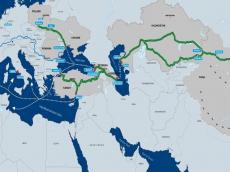|
|
TODAY.AZ / Business
Reviving silk road: Unlocking economic potential of Middle Corridor [COMMENTARY]
14 March 2024 [19:43] - TODAY.AZ

The Middle Corridor, also known as the "Middle Silk Road," is a strategic infrastructure initiative that aims to establish a multimodal transportation route connecting Europe and Asia through the Caucasus region. It is envisioned as a modern revival of the ancient Silk Road trade route, facilitating the movement of goods, energy, and people between Europe, the Caucasus, Central Asia, and beyond.
The Middle Corridor encompasses various transportation modes, including railways, roads, ports, and logistics centres, with the goal of enhancing connectivity and promoting economic development along its route. Key components of the Middle Corridor include the Baku-Tbilisi-Kars (BTK) railway, which connects Azerbaijan, Georgia, and Turkiye, providing a direct rail link between Europe and Asia bypassing Russia. Additionally, the Middle Corridor involves the development of maritime routes through the Caspian and Black Seas, as well as improvements to existing road networks.
This initiative is expected to boost trade, investment, and regional cooperation among participating countries, contributing to economic growth and development. It also holds strategic significance in diversifying transportation routes and reducing dependence on existing routes, thereby enhancing the resilience of global supply chains.
President Aliyev said the stakeholders need to combine efforts to make the Middle Corridor more commercially attractive.
“For that purpose, we already created a very efficient cooperation format between Azerbaijan, Georgia, Kazakhstan, and Türkiye. I think that if other countries in Central Asia, particularly Uzbekistan, would consider joining the format, it would be better for all of us. This really is a new map—a new transportation map of Eurasia with great potential.”
Here poses several questions: How do infrastructure investments along the Middle Corridor contribute to regional economic development? In terms of cost-effectiveness, how competitive is the Middle Corridor when compared to maritime routes for international trade? What economic challenges or barriers need to be addressed for the Middle Corridor to reach its full potential?
Muram Margvelashvili, Associate Professor of Illia University and Energy Director of "World Experience for Georgia, told Azernews that there are several direct and indirect ways for the Middle Corridor to contribute to regional economic development.

“First of all, the infrastructure investments and service infrastructure along the route create the economic activity that contributes to the economic growth of countries. The political stability, common standards, unified tariffs, and cooperation between countries that are a necessity for a successful Middle Corridor bring additional benefits to the business environment. Third, easy import and export routes create a supportive ecosystem for goods produced in the region. Politicians should keep in mind a bigger picture where the Middle Corridor is not only a transit route but also serves as the means for increasing the overall importance and economic potential of the region.”
According to him, the middle corridor is getting more competitive in the current volatile environment.
“The aggression of Russia in Ukraine, instability in the Red Sea created by Houthi attacks have significantly increased freight prices and hampered the delivery of goods to the EU. This makes the Middle Corridor even more competitive economically and adds a strong security of supply dimension to its operation.”
“There are many challenges and barriers that need to be addressed for the success of the Middle Corridor. Political stability and cooperation are a must. On the economic side, I would name infrastructure development as the primary task since efficient railways, roads, ports, and shipping capacities are crucial for seamless transit of goods. I could name the upgrade of the Baku-Tbilisi-Kars railway as one example of the needed interventions. Tariff harmonisation and a unified system of procedures and standards would be important regulatory contributions to economic success. Other factors include the efficiency and interoperability of logistics systems with the high level of digitalization,” Margvelashvili concluded.
URL: http://www.today.az/news/business/246014.html
 Print version
Print version
Connect with us. Get latest news and updates.
See Also
- 26 December 2024 [14:21]
Azerbaijani agency launches initiatives for cooperation with OTS - 26 December 2024 [12:43]
Energy Ministry reviews 2024 Progress on business environment - 25 December 2024 [13:38]
BHOS & Kazakhstan's Safi Utebayev Atyrau Oil and Gas University sign protocol - 24 December 2024 [12:44]
Azerbaijan's National Science Academy and ICRC strengthen co-op in forensic archaeology - 24 December 2024 [12:32]
Turning Landmines Into Grapevines In Post-War Azerbaijan - 24 December 2024 [12:05]
Azerbaijan’s renewable energy success cited as global example by UNECE - 23 December 2024 [20:19]
Aghdam Industrial Park welcomes new resident with metal manufacturing project - 23 December 2024 [18:41]
First meeting on unified information system for public utilities held - 23 December 2024 [11:46]
Azerbaijan's "e-social" portal wins prestigious award in UK - 21 December 2024 [16:30]
Azerbaijan, Russia inks agreement on Development of Transit Freight Transportation
Most Popular
 Multiple-firing weapons: how India fooled Armenia
Multiple-firing weapons: how India fooled Armenia
 BHOS & Kazakhstan's Safi Utebayev Atyrau Oil and Gas University sign protocol
BHOS & Kazakhstan's Safi Utebayev Atyrau Oil and Gas University sign protocol
 Immoral silence: our grief and the true face of European politicians
Immoral silence: our grief and the true face of European politicians
 Turkish President Erdogan offers condolences following AZAL plane crash
Turkish President Erdogan offers condolences following AZAL plane crash
 Gas case: The West fears the success of Azerbaijan's energy strategy
Gas case: The West fears the success of Azerbaijan's energy strategy
 Azerbaijan observes National Day of Mourning for plane crash victims
Azerbaijan observes National Day of Mourning for plane crash victims
 Pashinyan was "struck down" by a new type of coronavirus
Pashinyan was "struck down" by a new type of coronavirus
